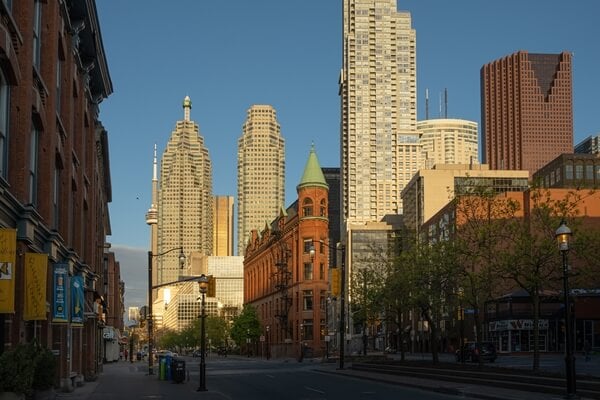Uncover the Rich Background Behind the Gooderham Building in Toronto
The Gooderham Structure, an excellent manifestation of Richardsonian Romanesque design in Toronto, has a fabled past that extends past its striking red brick frontage. Appointed by the prominent Gooderham and Worts distillery in 1891, this structure has actually played a critical role in forming the urban landscape of the St. Lawrence Market location.

Origins of the Gooderham Structure
Building an enduring tradition, the Gooderham Building, also understood as the Flatiron Building, emerged as an icon of Toronto's architectural evolution in the late 19th century. The building's origins map back to 1891 when it was commissioned by the Gooderham and Worts distillery, among copyright's largest distilling business. Developed by designer David Roberts Jr. Gooderham Building address., the framework was uniquely positioned at the crossway of Front and Wellington Streets, making the most of a triangular lot created by the merging of these highways
The structure's building made use of local red brick and terracotta, establishing a distinct aesthetic that enhanced the blossoming cityscape. Originally intended to house the Gooderham and Worts workplaces, the building stood for the success of the distillery, which had come to be a substantial factor to Toronto's economic climate. Significantly, the completion of the Gooderham Structure accompanied a period of fast urbanization that defined the age.
The establishment of this architectural gem not just showcased ingenious style but likewise laid the groundwork for future advancements in Toronto. Today, it stands as a testament to the city's abundant background and flexibility, remaining to attract visitors and admirers from around the world.
Architectural Value
The building significance of the Gooderham Structure extends beyond its distinct flatiron form, reflecting the innovative spirit of late 19th-century style. Completed in 1892, the structure exemplifies the Richardsonian Romanesque design, defined by its durable stonework, rounded arches, and complex detailing. The strong use of contrasting materials, specifically the cozy red brick and limestone accents, boosts its aesthetic charm and shows the craftsmanship of the age.
The building's three-story layout is noteworthy for its unified percentages and stylish cornice, which add to its legendary silhouette against the Toronto horizon. The slim whole lot on which it stands postured special obstacles, yet the architects, in this case, developed a structure that made the most of the available area while keeping visual equilibrium.
In Addition, the Gooderham Structure is a testament to the flexibility of building design in metropolitan atmospheres. Its long-lasting visibility amidst modern-day advancements illustrates the worth of preserving historic design as a way of honoring a city's past. Today, it stays a beloved site, showing both the building trends of its time and the advancing story of Toronto as a vibrant urban facility.
Function in Toronto's Growth
Becoming an essential gamer in Toronto's metropolitan landscape, the Gooderham Structure contributed dramatically to the city's development during the late 19th century. Constructed in 1892, this renowned pile stood for not just the building aspirations of the moment but also the growing economic landscape of Toronto. The building was at first created to work as a warehouse for the Gooderham and Worts distillery, which was among the largest distilleries in the British Realm. Its calculated area at the intersection of Front and Wellington Streets assisted in the movement of goods and solutions, emphasizing the area's relevance in the city's commercial activities.
As the city broadened, the Gooderham Structure ended up being an important part of the St. Lawrence Market location, which was a hub of trade and commerce. Its one-of-a-kind architectural design and famous presence drew focus, influencing the layout of succeeding structures in the location. The structure's survival with numerous financial changes and urban advancements reflects the resilience and versatility of Toronto's historic landscape. In essence, the Gooderham Building is not simply a building landmark; it played an essential function in shaping Toronto's identity and economic development throughout a transformative period in its history.
Social Influence and Tradition
Gooderham Building's distinctive building design and historical importance have left an enduring mark on Toronto's social landscape. As one of the city's most recognizable landmarks, its distinct flatiron form and elaborate brickwork exemplify the Victorian building trends of the late 19th century. This framework not just works as an aesthetic support in the St. Lawrence area but likewise embodies the spirit of an expanding city during an era of financial growth.
The structure has actually become a sign of Toronto's rich background, motivating regional musicians and professional photographers that look for to capture its charm. Its presence has actually fostered a sense of neighborhood identification, adding to the story of urban growth. In addition, the Gooderham Structure has actually played a critical role in the tourism sector, bring in visitors excited to explore its storied past and architectural beauty.
In addition to its visual allure, the structure envelops a narrative of resilience and adaptation, as it has transitioned through various uses over the decades - Gooderham Building address. Thus, the Gooderham Building stands not just as a monolith of architectural relevance however additionally as a testament to the evolving cultural heritage of Toronto

Restoration and Preservation Initiatives
Various restoration and conservation initiatives have actually been embarked on to guarantee the Gooderham Building stays an essential part of Toronto's architectural heritage. Initially completed in 1892, the structure has gone through significant restorations to address structural concerns while retaining its historic integrity. The most notable remediation happened in the late 20th century when the building was carefully refurbished to meet modern-day security criteria without compromising its initial layout elements.
These initiatives consisted of repairing the distinctive red-brick frontage, recovering the famous triangular shape, and preserving the elaborate masonry information. Additionally, the building's inside has actually seen careful updates that respect its historical importance, guaranteeing that original attributes such as wood beams and attractive moldings are maintained.
The Gooderham Structure is currently safeguarded as a designated heritage building under the Ontario Heritage Act, which helps guard it from improper modifications. Area interaction has played a critical function in these conservation efforts, with local advocacy teams increasing recognition about the structure's historical importance. Therefore, the Gooderham Structure stands not just as a practical area but also as a testimony to Toronto's rich architectural history and enduring social legacy.
Conclusion

Please visit one of our local supporters - Gamerama And The Repair Store - Iphone Repair Near Me